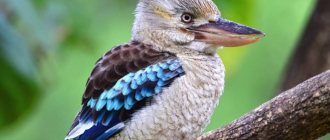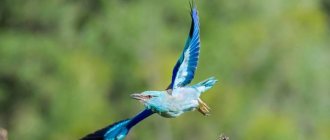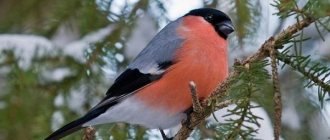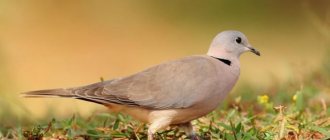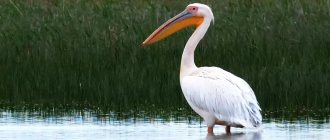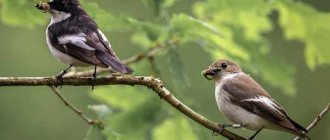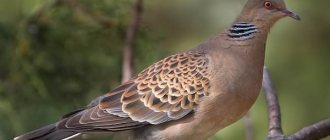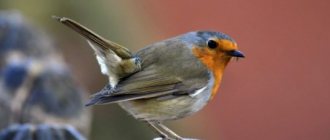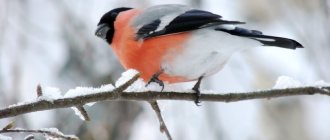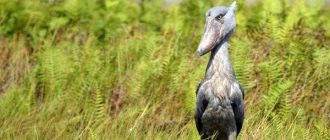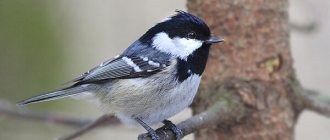- Wild animals
- >>
- Birds
The kingfisher is one of the most beautiful birds found in Europe. Due to its bright colors and small size, people call the kingfisher the European hummingbird, and they are not far from the truth, since both of these birds are very beautiful and graceful in the air. According to biblical legend, the kingfisher received such a bright color after the Great Flood. Noah released the bird from the ark, and it flew so high that its feathers became the color of the sky, and the sun scorched its breast and it became red.
Description of the kingfisher and origin of the name
The kingfisher is a miniature bird (about the size of a tit or sparrow) belonging to the kingfisher family of the order Coraciiformes. Close relatives of colorful birds are rollers, bee-eaters, momots and todies.
The Jamaican tody is a relative of the kingfisher.
Why is the kingfisher called that?
Some people mistakenly believe that the Russian name kingfisher comes from the fact that these birds are born in winter. But members of the family produce offspring in spring and summer. In fact, the name “kingfisher” is derived from the word “shrewfisher” (born in the earth) - birds really nest in holes on steep banks.
According to another version, the bird got its name because the kingfisher’s body is always much colder than that of other birds. For the same reason, the German name eisvoge, which translates as “ice bird,” came about.
Kingfishers in the mythology of Ancient Greece were called alkonostas. This name for the birds was formed from the concept of “halcyon days” (the week before and the week after the winter solstice), because it is believed that it was during this period that the birds nested in the Adriatic.
The Latin name for kingfishers is Alcedinidae, and the English call these birds kingfisher (fisher king) because of the birds' unique fishing abilities.
Kingfishers also have other nicknames:
- due to their bright colors, members of the family are called overseas parrots or European hummingbirds;
- Due to the ability to dig nests in the ground, the bird received the name burrower.
Kingfisher with fish in its beak
Natural enemies
The kingfisher family has a high mortality rate due to various reasons. But thanks to their high level of reproduction, their population numbers are recovering quite quickly.
Rare birds of this genus live up to three years. 70% of the entire kingfisher population are young birds.
The mortality rate of young birds is very high: 70 - 80% of young birds do not survive the first year.
Many drown in their first attempts to catch fish, others freeze in winter due to wet feathers after fishing.
Kingfisher trying to stay warm when it's snowing and raining
Death from starvation and from predators is common.
Predators that hunt kingfishers include cats, otters, ferrets and minks. Often rats come and destroy nests and eat eggs and offspring.
Today, the population is seriously damaged by human activity, such as water pollution, changes in the landscape, and movement by motor boats during the spawning period, which coincides with the nesting of kingfishers.
Appearance of a kingfisher
Most members of the family are small birds. Here are some numbers:
- the average body length of a kingfisher reaches 16–20 cm;
- wing length - 7–8 cm;
- the wingspan reaches 25–29 cm;
- The weight of an adult is 25–45 g.
INTERESTING FACT . The smallest size is the African dwarf kingfisher, whose body weight is only 10 g. The largest kingfisher is the kookaburra, whose weight reaches 400–500 g.
Kookaburra is the largest representative of kingfishers
The body of kingfishers is dense, with thick plumage. The head is also quite large and stands out against the background of the body. The beak of birds varies depending on the species. Thus, in the common kingfisher it is straight, long and sharp, in the kookaburra it is wide and powerful, which allows the bird to crush amphibians. Those birds that feed on worms (African kingfisher) have a curved beak at the tip to make it easier for birds to rummage in the ground.
The wings of most individuals are short, rounded at the ends. Consist of 18–20 flight feathers. The tail is also short, most often rectangular.
The unique structure of the limbs of this bird. The legs of the kingfisher are very short, four-toed. Three fingers pointing forward are almost completely fused, making it quite difficult for birds to hold on to thin branches and move on a flat surface.
Photo of a kingfisher preening its feathers
The kingfisher is a colorful bird, but the color varies greatly between species. The head, back, wings and tail of most members of the family are colored blue-blue, violet or azure with a metallic tint; piebald kingfishers have predominantly black and white and gray plumage, while kookaburras have brown plumage. The belly and undertail can be from white to bright red (the orange tint is due to the presence of carotenoids in the cells).
The beak of these birds is predominantly gray, black or red.
Coloration of the piebald and common kingfisher
Male and female kingfisher: main differences
In most species of the family, the female and male individuals differ in size - the male is slightly larger than the female (his weight is only 2-5 g more).
Individuals can also be distinguished by the brightness of their plumage - the color of the male is richer than that of the female. In the common kingfisher, you can distinguish a male from a female by the color of its beak - in the first it is completely black, and in the female the lower part of the beak is orange.
Sexual dimorphism is most pronounced in the striped kingfisher: the female of this species has predominantly chestnut-red plumage (with black stripes), the male has only brown cheeks and forehead, the rest of the body is colored blue.
Similarities and differences between male and female striped kingfisher
Appearance of the bird
This baby's body size is really small. Its length is about 16 centimeters. Adult kingfishers weigh approximately 40 grams. The size of the wingspan is 25 centimeters.
Kingfisher bird (lat. Alcedo atthis)
The color of the bird's feathers is simply mesmerizing with its beauty! Just look at it, you can’t even believe that such a colorful bird can live in our area, it seems that it flew in from somewhere far away, where exotic animals live! The back and wings of the kingfisher are sky blue, the abdominal area is bright red. There are white spots under the beak and on the sides of the head. And the paws are orange-red. A real beauty, isn't she?
Kingfisher singing
Kingfishers are not songbirds, but do make various sounds during hunting or mating season. The common kingfisher has a sharp and sonorous voice; most often you can hear from it the loud squeak of “tiu”, “tiik”, “tiit”, “tiip-teip”. The striped kingfisher makes a continuous "wheeeeeeeeeeeee" sound for about 15 seconds.
But the most unusual sounds from the representatives of the family are reproduced by the kookaburra. We can say that this kingfisher sings even frighteningly, and its screams resemble human laughter. The song starts with a clicking sound and goes into a loud “ha ha ha.” The main reason for the singing of birds of this species is to mark their territory. Often kookaburras even scream in unison.
We invite you to watch the video and listen to the singing of a kookaburra or a laughing kingfisher.
Lifespan
Kingfishers are thought to be long-lived , but the survival rate and lifespan of most species is unknown. It is believed that the survival rate of one-year-old chicks ranges from 25 to 55%. The common kingfisher is one of the most famous centenarians, the oldest of which died at the age of 15 years and 5 months.
Causes of death for kingfishers include predation and collisions with man-made structures such as windows, towers and buildings during their nocturnal migrations.
Kingfisher species
In nature, there are more than 110 species of these birds, which are grouped into 3 subfamilies and 19 genera:
- Alcedo kingfishers;
- forest or three-toed (Ceyx);
- African forest (Corythornis);
- tiny kingfishers (Ispidina);
- small piebalds (Ceryle rudis);
- great piebalds (Megaceryle);
- green kingfishers (Chloroceryle);
- Kingfishers Actenoides;
- alcyones (Halcyon);
- satin alcyones (Caridonax fulgidus);
- blue-eared kingfishers (Cittura cyanotis);
- frogmouths or crabeater kingfishers (Clytoceyx rex);
- kookaburras (Dacelo);
- striped kingfishers (Lacedo pulchella);
- Melidora (Melidora macrorrhina);
- gurials or stork-billed kingfishers (Pelargopsis);
- paradise kingfishers (Tanysiptera);
- Pacific (Todiramphus);
- kingfishers Syma.
Let's look at the most common and unique species of kingfishers.
Common or blue kingfisher. This is one of the most numerous representatives of the family, living in Eurasia, northeastern Africa, Indonesia and the Pacific Islands. Birds of this species are of medium size (weigh from 25 to 45 g) and have bright plumage: the head and back are colored predominantly green-blue, the belly and cheeks are red, and the mandible is white.
The common kingfisher is the most numerous member of the family
Three-toed forest or ruby kingfisher . Distributed in the southern and southeastern parts of Asia. This representative has a dark purple, blue or even black upper body, a red-pink tail, a bright orange top with a purple tint, and a yellow belly. The beak of the birds is also bright - yellow-orange.
Ruby kingfisher - an inhabitant of the forests of Asia
Great Pied Kingfisher. The main habitats are Korea, eastern and southeastern parts of China, Eastern and Central India, and the Japanese islands. The species is also found on Kunashir Island (Kuril Islands). There are only 20 pairs of individuals here; for this reason, this kingfisher is listed in the Red Book of Russia.
Large piebald kingfishers are one of the largest representatives of the family, the length of these birds reaches 45 cm. In terms of color, the birds are inferior to many of their relatives - the plumage is predominantly gray-white, but males have a red-red stripe on their necks. A distinctive feature of the birds is the crest on the head.
Male Great Pied Kingfisher
Blue-eared kingfisher. It is endemic to the Indonesian island of Sulawesi. The body length of an adult individual of this species reaches 30 cm; a notable feature of birds is their long tail. The main color of the plumage of birds is brown, only a dark blue stripe runs from the beak to the back of the head, which is why the species got its name.
Blue-eared kingfisher is endemic to Sulawesi
Blue-breasted alcyone. Representative of central and western Africa. Most of this bird's body is light turquoise and black. The belly is predominantly white or light gray, but there is a blue-blue stripe on the upper part. The feathered beak has an unusual color: its upper part is red, the lower part is black.
Blue-breasted alcyone - representative of Africa
Stork-billed gurial. The species is distributed in Indonesia, India and the Philippine Islands. The color of the plumage of the back, wings and tail is blue-black or purple, the belly is yellow-cream, the crown of the head is buffy-brown. The beak is unusual among birds - it is powerful and wide, colored mainly red, only the tip is black (like a stork).
Stork-billed gurial - inhabitant of India, Indonesia and the Philippines
The kookaburra or giant kingfisher lives in Australia and on the island of New Guinea. This genus includes 4 subspecies, the largest representative is the laughing kookaburra. The birds are colored grey, white and brown; the blue-winged and Aruan kookaburras also have a blue-blue tint in their plumage. The most unusual representative of the genus is the red-bellied kookaburra, whose belly is colored red-brown, and the beak of this bird is completely white.
INTERESTING FACT. Recordings of kookaburras' calls are used as jungle sounds in films, television programs and even on some Disneyland attractions.
Red-bellied kookaburra - native to Australia
Scientific classification
- Kingdom: Animalia (animals)
- Phylum: Chordata
- Class: Aves (birds)
- Order: Coraciiformes (Coraciiformes)
- Family: Alcedinidae (kingfishers)
114 species in the kingfisher family . They are divided into 3 subfamilies and 19 genera. The subfamily Alcedininae includes most of the "fishing" kingfishers, the subfamily Cerylinae - the New World kingfishers, the subfamily Halcyoninae - the "forest" kingfishers.
Kingfisher range and habitat
Birds of this family are distributed mainly in Eurasia, Australia and Africa, but are also found in Central and South America (green kingfishers). Birds are thermophilic, therefore they inhabit subtropical, tropical and subequatorial zones. In Europe, kingfishers also live in temperate climates (they occupy territories south of Scandinavia).
Of all the species in the family, the common kingfisher has the widest range, which can be found in the southwestern, eastern and southeastern parts of Eurasia, northwest Africa and the Pacific Islands (off the northern coast of Australia).
Distribution areas of the common kingfisher on the map
There are 5 species of kingfishers found in Russia:
- the common kingfisher lives throughout the European part south of St. Petersburg, in the Asian part it inhabits the Southern Urals, the south of Central Siberia, Transbaikal, Primorsky, Khabarovsk territories, as well as the Amur and Sakhalin regions;
- great piebald - lives on the Kuril Islands (Kunashir and Shikotan);
- the small piebald kingfisher was recorded in the lower reaches of the Volga;
- collared alcyone is found in the south of Primorye;
- fiery alcyone - birds can be seen on Sakhalin.
Flaming alcyone - an inhabitant of Sakhalin
Habitats
Kingfishers are primarily forest dwellers. In Asia they prefer to settle in dense evergreen forests, in Africa - in humid tropical jungles. But the main criterion for choosing a habitat is the presence of a clean body of water with running water nearby (a river or a mountain stream), where birds can hunt. The exceptions are the African tiny kingfisher, striped kingfisher and alcyones, which settle in dense thickets or meadows far from water.
In Russia and European countries, the favorite habitats of the kingfisher are high river banks overgrown with cattails or shrubs. Birds choose bodies of water in sunny places where the top layer of water warms up well.
Common kingfisher flying over the water
Migratory or wintering bird
The kingfisher is a migratory and wintering bird. The inhabitants of Africa, Asia, Australia, and the Pacific Islands spend the whole year in one place. Kingfishers of the North Caucasus also winter in their usual territory.
Those birds that nest in Eastern and Central Europe fly to North Africa in winter. From Siberia, common kingfishers migrate to the southern part of Asia. Migration begins in the first half of August, but some birds also fly away in October. Migratory species return in March–April.
Blue-winged Bird Lifestyle
Mature individuals lead a strictly isolated lifestyle. They occupy a certain area, which necessarily includes a body of water. Birds living in the northern regions fly south for the winter, sometimes 2000 kilometers away. Kingfishers return in the spring.
A pair of kingfishers rests on a branch with fluffy moss.
These birds prefer to live along the banks of various bodies of water: rivers, ponds, ditches, large streams, lakes, because the main source of food for them is fish and other aquatic animals. A prerequisite for the kingfisher is the presence of a steep bank on which it builds its nest. Outside the nesting season, kingfishers can be found in close proximity to populated areas: villages and even cities.
Behavior and lifestyle
Kingfishers can be called true introverts: they spend their entire lives alone, pairing up only for the breeding season. When choosing a place of residence, birds prefer territories that are as far as possible from human eyes and approximately 0.5–1 km from the nests of other birds.
The kingfisher is a very fast and attentive bird, which helps it in hunting. Due to the structure of the paws of these birds, they move on the ground reluctantly and spend more time flying or sitting on branches. Birds are active only during daylight hours, and the main part of the kingfisher’s day is spent searching for food, or more precisely, catching fish.
Pair of common kingfishers in natural environment
What does the kingfisher eat?
All representatives of this family eat animal food. The main part of the kingfisher's diet is fish, which the birds skillfully catch from the water. Birds are very voracious; they can eat up to 10–12 small fish per day (which is approximately 20% of their own body weight).
If the catch in the habitat of the kingfisher is small, the birds do not refuse:
- aquatic insects;
- dragonflies;
- frogs;
- crustaceans;
- lizards;
- snake.
INTERESTING FACT. The tiny African kingfisher feeds on forest insects and worms, the alcyone kingfisher feeds on rodents, and the kookaburra can even eat the chicks of other birds.
White-breasted kingfisher eating a snake
The kingfisher is a skilled fisherman. It can fly low over the water, freezing in the air for some time and peering into the depths. But most often the bird sits on a branch above the water at a height of 5 to 10 m and looks out for prey. Seeing the victim, the kingfisher dives into the water, pressing its wings to its body. The bird kills the caught fish by hitting a branch or stone.
A kingfisher can destroy prey right next to a pond, but more often it drags it to its nest. The bird starts eating fish from the head so that it does not get stuck in the throat. By the way, fish bones, fins, and scales remain in the burrows of these birds (the birds regurgitate them), so an unpleasant odor always emanates from kingfisher houses.
We invite you to watch a short video of a kingfisher catching fish.
Communication and perception
Kingfishers have excellent eyesight, and they rely heavily on vision to hunt. However, they cannot move their eyes in their sockets, which is why kingfishers move their heads when stalking prey. Their eyes have two pits that allow them to very accurately determine the distance to the prey object by slightly turning their head. Their eyes are also particularly rich in oils that improve color vision. At least one species of kingfisher is capable of seeing near ultraviolet light. When some kingfishers dive for fish, their eyes are closed by a nictitating membrane. This means that these species must rely on their sense of touch to determine when to close their beaks to catch fish.
Photo: Fayne
Kingfishers are very loud birds . Loud calls are used to mark personal territory, and quieter calls are used for communication between family members. Some pairs of kingfishers sing duets, and cooperative groups of kookaburras sing in chorus at dawn and dusk. Although the vocalizations of most species have not been well studied, those species that have been studied often have several different vocalizations. For example, the North American collared kingfisher uses at least six calls in various combinations to convey messages. Some species also produce voiceless sounds, such as beak tapping.
Population and species status
Most kingfisher species are widespread and not at risk of extinction. But due to pollution of the birds’ usual habitats (clean, transparent water bodies), the number of individuals is constantly declining. Recently, these birds even look into fish farms and city ponds in search of food.
The largest population today is of the common kingfisher, but even despite this, the birds are listed in the Red Books of Russia and Belarus. Among tropical genera there are also endangered ones.
- The blue-eared kingfisher is endemic to Sulawesi, and the number of individuals of this species is declining due to deforestation.
- Micronesian alcyone. Three subspecies of these birds are endemic to the islands of Guam, Palau, Pohnpei, and the subspecies Todiramphus miyakoensis, found on the Japanese island of Ryukyu, was completely destroyed in 1919.
Micronesian alcyone - an endangered species of kingfisher
Natural enemies in the wild
Birds of the kingfisher family have few enemies in the natural environment - birds most often become prey for hawks or falcons. These birds provide good protection from predators with their bright plumage, thanks to which the kingfisher can successfully camouflage itself in the wild. Also, their maneuverability and speed often help adults escape from enemies - birds of paradise in flight can reach speeds of up to 70 km/h.
Although the kingfisher has no commercial value for humans, some people hunt these birds to make stuffed animals out of them.
How long do kingfishers live?
In their natural environment, birds can live on average 12–15 years. Before this period, young individuals usually die because they cannot resist predators. Adult kingfishers can die, for example, during long flights to wintering grounds.
The falcon is a natural enemy of the kingfisher
Interspecies interactions
There is relatively little information on predation by adult kingfishers. Kingfishers are fast fliers and can probably elude most predators. But their nests can be destroyed by foxes, minks, dingoes, skunks, raccoons, owls, chimpanzees, snakes, monitor lizards, Dorylus ants and mongooses.
When threatened, kingfishers use one of two strategies:
- try to evade a predator by hiding behind trees or diving into the water;
- attack the predator directly, chasing it until it leaves the territory.
Some species have alternative strategies. Yellow-billed kookaburras raise their head feathers when threatened, revealing two black spots that resemble large eyes. Alarmed young red-backed kookaburras adopt a pose with their eyes closed and beak pointing upward, giving them the appearance of a tree branch from above.
How do kingfishers reproduce and what kind of offspring do they produce?
In temperate latitudes, the mating season for kingfishers occurs in April–May; in the tropics it can begin as early as March.
Since kingfishers do not have a beautiful voice, the male attracts the female during lekking flights, and then brings her a treat. If the female accepts it, a pair is formed. If not, the male looks for a new individual.
Birds make burrows together on high river banks. They first dig the ground with their beak, and then scoop out the sand with their paws. The length of the hole can reach 1 m. The diameter of the entrance is only 4–6 cm (so that predators do not get through), but inside the nesting cave is spacious - approximate size 20x20x15 cm. The kingfisher's nest is not covered with anything; over time, waste from food (fish bones) is collected in it , scales, fins) and shell.
Male and female common kingfisher at a burrow
The female lays an average of 5–8 eggs; they are almost round (diameter 22–24 mm), white, and shiny. Both individuals incubate the eggs in turn; after about 20–22 days, blind, naked chicks hatch.
Young individuals are very voracious, so parents have to catch up to 100 fish (3–4 cm long) every day. But even such fry do not always immediately fit into the beak of the chicks; part of the fish can stick out from the throat of the young until the already swallowed head is digested.
The chicks make their first flights from the nest at the age of 25 days, and after 1.5 months they become completely independent. The color of the young animals is almost no different from the adults, only until the first molt (at about 6 months) the color of the young ones’ plumage is dominated by green color. Puberty in kingfishers occurs by 1 year.
Feeding kingfisher chicks with fish
It is noteworthy that in one season a female can make up to 3 clutches at the same time, so the nesting period is very extended - lasts from May to August.
INTERESTING FACT. Despite the fact that kingfishers are considered monogamous birds, the male often starts a family on the side. And when the second “wife” has chicks, the father also regularly brings them food.
At the end of nesting, a pair of kingfishers usually splits up, after which the male and female can start fights with each other and fly to wintering in different flocks. But next year the individuals converge again and even live in the old nest.
Reproduction
Breeding season
Most species are monogamous , and many remain with partners for life. Polygyny is known to occur in at least one kingfisher species; male blue-eared kingfishers from Russia often breed with two to three females.
Courtship rituals include aerial chases, individual and communal aerial flights, displays of colorful plumage, and feeding of females.
Breeding pairs fiercely defend the territory, chasing intruders and, if necessary, fighting them in the air, sometimes falling to the ground or into the water where the fight continues. Particularly aggressive neighbors may even enter each other's nests to puncture the eggs. Territory size varies depending on species, food abundance, and nesting sites.
Photo: misooksun
Some kingfisher species are cooperative breeders . Such pairs have from one to several “helpers” who help defend the territory and feed the chicks. These are often juveniles from previous broods and may remain in the natal group for several years, greatly increasing the survival rate of the chicks.
Kingfishers most often nest on earthen banks, such as along rivers or lakes. They also use termite nests and tree cavities made by other bird species, such as woodpeckers. If they are not available, kingfishers gouge a hole in the wood (if it is rotten enough) or in another substrate. The male and female work together to create a spacious cavity by taking turns pecking at the substrate and then using their feet to scrape off the loosened material. The tunnel leading to the kingfisher's nest can be up to three meters long . The cavity is slightly larger in diameter than the tunnel and is not lined with any material. It can take up to a week to excavate the nest. Pairs often use the same nest for many years.
Photo: Dorothea OLDANI
Breeding seasons vary considerably within this family. Typically, kingfishers in temperate regions breed in the spring and summer. Those species that live in tropical regions may breed year-round or seasonally during periods of greatest prey availability.
Most kingfishers studied begin breeding at one year of age and can raise one to four broods per year under favorable conditions. In some cases, the male may even begin digging a tunnel for a new nest before the chicks from the previous clutch have fledged.
Chick development
The female lays 2 to 10 (usually 3 to 6) white eggs weighing 2 to 12 grams each. Eggs are laid approximately one day apart and incubation begins either after the first egg is laid or after most of the eggs have been laid. Both sexes take part in incubation and care of the chicks. Incubation lasts from two to four weeks, and the nesting period lasts from three to eight weeks.
Photo: Australian Museum
The chicks hatch blind and naked . Feathers appear in three to eight weeks depending on the quality of food. Both parents feed the chicks with regurgitated and then whole prey.
When the chicks are large enough to fly on their own, the parents may withhold food for several days to encourage the chicks to leave the nest. Some kingfishers also train their young to hunt. For example, the North American collared kingfisher throws dead prey into the water to allow their young to practice diving. After three weeks of additional feeding, adults usually force their young to leave their home territory.
Adult kingfishers do not engage in any nest sanitation, such as throwing feces out of the nest. Since most kingfisher nests have only one exit hole, the nests can become quite foul-smelling and often become infested with larvae due to accumulated chick feces and food debris.
Is it possible to keep a kingfisher at home?
Kingfishers are not tame birds. They are not bred for singing and are not raised for commercial purposes. An adult that ends up in a human home will most likely quickly die in captivity - these birds must get their own food, so without fishing they wither away. But you can try to raise a found kingfisher chick at home.
The cage for a bird should be spacious (remember the kingfisher’s love of flying), and it is better to place an adult bird even in an aviary. In addition to the drinking bowl and feeder, the kingfisher must have a large branch in the house, since the bird will spend most of its time on it.
You can immediately feed a young kingfisher in captivity with a mealworm. When the chick grows up, the bulk of its diet should be raw fish.
Micronesian alcyone in an enclosure at the zoo
Eating habits
Diet
Most kingfisher species consume relatively large invertebrates, especially grasshoppers, earthworms and crustaceans, as well as small vertebrates, including reptiles, fish and amphibians. Aquatic species are excellent at catching fish, frogs, shellfish and snakes.
Photo: Dorothea OLDANI
Relatively terrestrial species feed on a variety of foods, from arthropods (insects, spiders, centipedes) to small mammals and small birds. Some kingfishers eat fruit.
Hunting technique
Kingfishers spend a lot of time sitting still, looking for prey. Having discovered prey, they jump down to grab prey on the ground, in water, in the air or among leaves.
Prey is usually killed by striking it repeatedly against a branch or other hard substrate and then eaten whole . One species, the frog-mouthed kingfisher from the rainforests of New Guinea, specializes in digging up earthworms, which is why it has a flat, thick, spade-like bill.
Legends of the Kingfisher
Many legends are associated with these birds. According to Japanese legend, the kingfisher and sparrow were once brothers. The parents sent the grown birds to the city to earn money, where the sparrow worked hard, and the kingfisher only had fun and dressed up beautifully. After some time, the news came that the parents had died, and the sparrow quickly rushed to the funeral, but the bright dandy was late, as he had been choosing an outfit for a long time. Everyone put the kingfisher to shame, and since then he has been hiding in secluded corners and is rarely seen.
There is another legend, a Christian one. Noah sent a kingfisher and a dove to search for land. The Fisher King was overtaken by a storm, and he rose higher and higher. There, in the blue of heaven, the bird colored its wings azure blue, and when it flew to the sun, it scorched its breast, and it became orange. Having descended back to the sea, the kingfisher did not find the ark, and since then it has been flying over the water.
In ancient Greek mythology, Alcyone, the daughter of Aeolus, upon learning of the death of her husband Keik at sea, threw herself into the depths of the sea. The husband and wife turned into kingfishers. It is believed that during the two-week calm that sets in on the Aegean Sea (before and after the winter solstice), the bird nests. And in Russian art, based on this myth, the Alkonost bird appeared, with the hands and head of a woman.
Mythical bird Alkonost - kingfisher in Russian art
In many European countries, the kingfisher is considered a bird that brings good luck:
- in Germany, birds are a symbol of wealth and prosperity, so people want to have stuffed kingfishers in their homes;
- in Italy and France, these birds are more often called birds of paradise and photographs of them are hung in homes for good luck.
Reproduction
The male courts the female in a rather trivial way: he presents her with a caught fish. If the gift is accepted, the birds become a pair. For the most part, as mentioned above, kingfishers are monogamous, reuniting annually after wintering, the same family breeding offspring in last year’s place. There are known exceptions when a male prefers polygyny, caring simultaneously for several females and offspring, respectively.
The housing construction process deserves special mention. Both birds dig it, scooping out the earth with their beaks and paws. If during the construction process an obstacle is discovered in the ground, the hole is abandoned and a new one begins to be dug. The entire process usually takes a week.
In the finished home, the female lays 7-8 eggs. Parents take turns incubating the chicks. It should be noted that the offspring are quite voracious; one chick can eat more than its weight in a day. Little kingfishers are born blind and naked. It takes three weeks to fully feather, after which the brood is ready to leave the nest. This happens around mid-June. From this moment on, the parents feed the chicks for several more days and, most often, make a new clutch of eggs. Thus, kingfishers can manage to breed offspring 2, less often 3 (in the southern regions in early spring) times over the summer.
The distance between the houses of different pairs is quite large and ranges from 300 meters to 1 kilometer. So, despite their apparent fertility, the number of these birds decreases every year. And the reason does not lie in natural enemies, of which kingfishers have almost no enemies. It is difficult to hunt a bird that skillfully hides under the canopy of foliage, and in flight reaches speeds of up to 80 kilometers per hour. The main reason for the decline in the number of kingfishers is people destroying their natural habitat. It is because of its activity that it is increasingly difficult for birds to find a clean forest body of water.
Interesting facts about the kingfisher
Here are some more interesting facts about the fishing kings.
- The kookaburra or giant kingfisher is the symbol of Australia. The laughter of this bird begins broadcasting on some Australian radio stations. The kookaburra was also one of the mascots of the 2000 Olympic Games held in Sydney.
- During the Roman Empire, the bright feathers of kingfishers were very valuable (like gold and jewelry) and were exported as trophies. And in China, fans, changing screens, and even blankets were decorated with feathers.
- Birds are also popular in modern culture: in the computer game Assassin's Creed Odyssey there is a task called “The Kingfisher and the Blackbird.” And the kookaburra, for example, was mentioned in the game World of Warcraft.
Description
In pictures these birds appear large, but in reality they are slightly larger than starlings. The male kingfisher is larger than the female, and they are the same in color. Their unbulky heads are decorated with small light-colored splashes. An elongated, thin beak with four edges, smoothly tapering at the end. A short tail unusual for birds, an unusually short tail for a bird, variegated bluish-greenish plumage, stripes from the eyes to the back of the head. Such characteristic features make it easy to recognize the kingfisher among a large class of birds.
Kingfisher photo bird, why is it called that
This is what a kingfisher bird looks like
I’m intrigued, and now let’s look at the photo and try to give a description of the kingfisher, this most mysterious bird for humans, it’s not for nothing that they gave it an equally mysterious name - kingfisher. Why is it called that? The main legend of the origin of the name kingfisher says that this is a distorted name for a bird that lives and gives birth (hatches) its chicks in the ground, in burrows - shrew!
But in our area there is another legend: take any bird in your hands, it is warm, but the kingfisher is always cold, the winter genus is cold. Apparently the bird has adapted to burrow life and the cold water of reservoirs where it finds food. Try to sit for hours above the surface of the water on a twig or reed, looking out for prey, and you will inevitably become cold, and this is exactly what the kingfisher does when getting food for itself.
The kingfisher settles exclusively near rivers with clean and running water. If conditions permit, the river has ice-free sections or channels, and remains for the winter in the same place where it was born. Recently, the kingfisher in Russia can often be seen in the North Caucasus.
In Russia, the kingfisher is found in the forest-steppe and steppe parts of Siberia, near the cities of Krasnoyarsk and Novosibirsk, in the upper reaches of the Yenisei. It is found in Kazakhstan, Belarus, Ukraine along the Desna River, Zaporozhye and in the Rivne region. Recently, kingfishers have begun to be seen in the southwest of Crimea; I myself saw one in Balaklava, while serving in the Navy.
In fact, representatives of the kingfisher genus live in Africa, southern Asia and Europe, Australia and New Guinea. In Russia we have the common or blue kingfisher.
